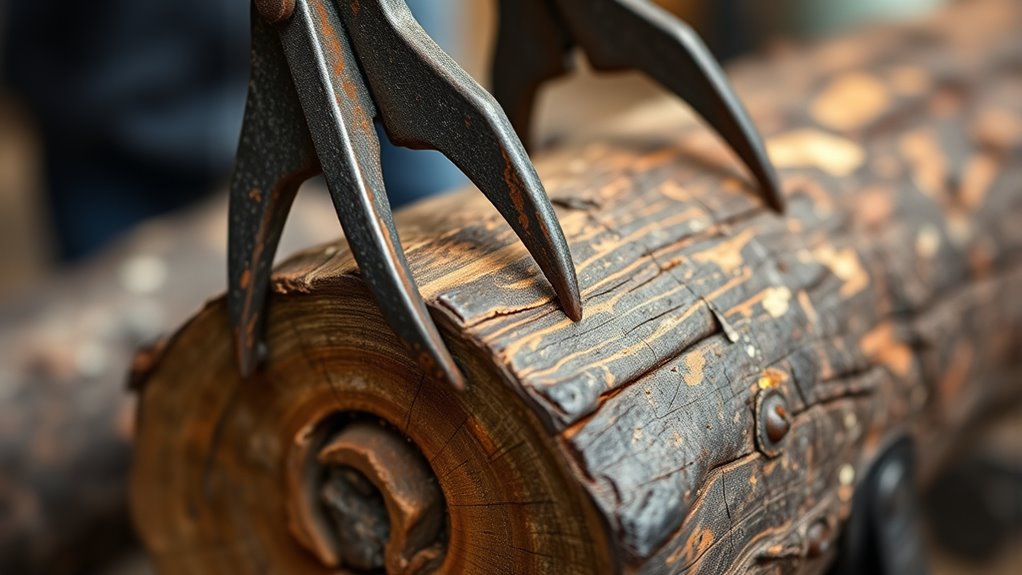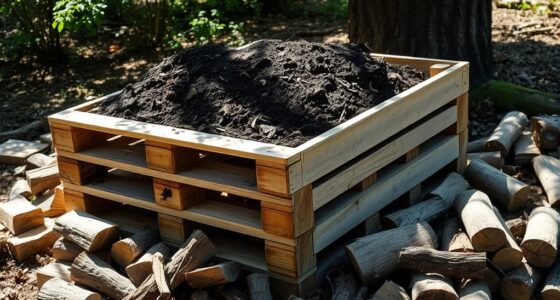To make homemade log tongs from scrap steel, start by selecting sturdy, clean steel pieces and carefully cut and shape them into jaws and handles. Focus on designing ergonomic handles and secure joints for a good grip and safety. After assembling everything, apply rust-proof coatings and test the tongs for strength and stability. With proper shaping and finishing, you’ll craft durable tongs that work well—if you’d like to see each step in detail, keep exploring the process.
Key Takeaways
- Select sturdy, rust-free steel scrap and accurately cut and shape the components for the tongs.
- Design ergonomic handles and secure them firmly to ensure comfortable grip and control.
- Forge or form the steel into a gripping jaw and handle assembly, using heat treatment to enhance hardness.
- Weld the parts together with proper alignment, ensuring even pressure and secure joints.
- Finish with rust-proof coatings, smooth surfaces, and conduct safety tests for reliable, long-lasting tongs.
Gathering and Preparing Your Materials

Before you start building your homemade log tongs, you need to gather the right materials and prepare them properly. Start by collecting metal scrap, such as steel, that’s sturdy enough to handle the weight of logs. Inspect each piece carefully for rust, cracks, or weaknesses, discarding any compromised sections. You’ll also want to gather essential safety gear—gloves, eye protection, and a dust mask—to keep yourself safe during cutting and welding. Proper preparation means cleaning the scrap steel to remove rust and debris, ensuring a cleaner weld and better grip. Considering best airless paint sprayers in your workspace and taking precautions can prevent accidents while working with metal. Measuring and cutting your metal pieces precisely is crucial to ensure they fit together securely. Taking these steps now will set a solid foundation for building effective, durable log tongs. Additionally, understanding metal preparation techniques can significantly improve the quality of your welds and the overall durability of your project.
Designing Your Tongs for Optimal Grip
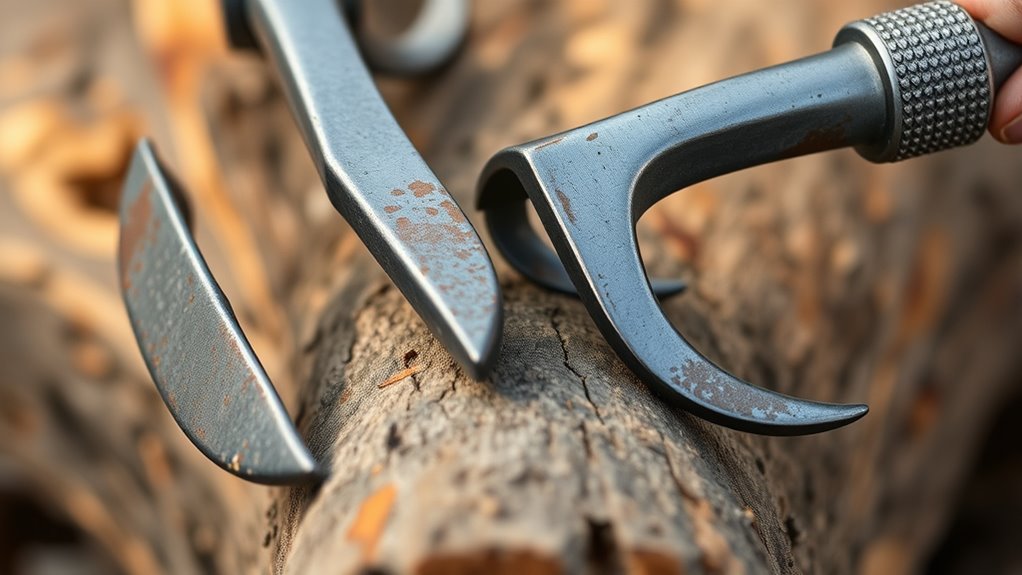
To guarantee your log tongs grip securely and comfortably, you need to focus on handle ergonomics and comfort. A well-designed handle reduces fatigue and increases control during use. Additionally, optimizing clamping force and stability keeps logs secure, making your work more efficient and safe. Incorporating ergonomic design principles can also lead to more natural and comfortable handling, reducing strain during extended use. Embracing artistic expression in your design process can also inspire innovative features that improve grip and functionality. Considering automation’s role in business intelligence can provide insights into optimizing your tool design process, leading to better performance. Being aware of security measures in your workspace can help protect your tools and ensure a safe environment during your woodworking projects.
Handle Ergonomics and Comfort
Designing your log tongs with ergonomic handles guarantees you can grip them comfortably and securely during use. Focus on handle design that fits well in your hand, reducing fatigue and increasing control. Use smooth, rounded edges to prevent pressure points, and consider adding slight contours to match your grip naturally. Choose materials that provide a non-slip surface, especially if your hands get sweaty or cold. Keep the handle length appropriate—long enough for leverage but not so long that it becomes unwieldy. Prioritize grip comfort by testing different shapes and sizes before finalizing your design. An ergonomic handle not only enhances safety but also makes your log handling more efficient and less tiring, ensuring you can work longer with less strain. Additionally, selecting handles with preppy dog names can inspire a more stylish and personalized touch to your tools. Considering the impact of handle ergonomics on overall safety and efficiency can lead to better tool performance. Incorporating proper grip techniques can further improve your control and reduce the risk of injury during logging tasks. To achieve optimal results, it’s beneficial to understand how self-understanding influences your approach to tool design and safety. Recognizing the importance of hybrid bicycle features can also help in understanding ergonomic principles applicable to handle design.
Clamping Force and Stability
Achieving the right clamping force is essential for ensuring your log tongs grip securely without slipping. To do this, focus on optimizing the jaw grip so it distributes pressure evenly across the log’s surface. Proper pressure distribution prevents weak spots that could cause slipping or uneven holding. When designing your tongs, make sure the jaws apply consistent force along their entire length, rather than concentrated in one area. You can achieve this by adjusting the hinge placement and leverage points. Too much pressure can damage the log, while too little reduces stability. Aim for a balance that firmly secures the log without deforming it. Considering the material properties of the steel and wood can help you fine-tune this balance for maximum effectiveness. Additionally, understanding the pressure distribution across the jaws can significantly improve grip stability. Incorporating pressure analysis during design can help optimize these factors for better performance. Understanding the material characteristics of the steel and wood can further enhance your design process. Paying attention to force application methods can also improve the overall effectiveness of your homemade tongs. With careful attention to clamping force and pressure distribution, your homemade tongs will hold logs securely and safely during lifting and transport.
Cutting and Shaping the Steel Components
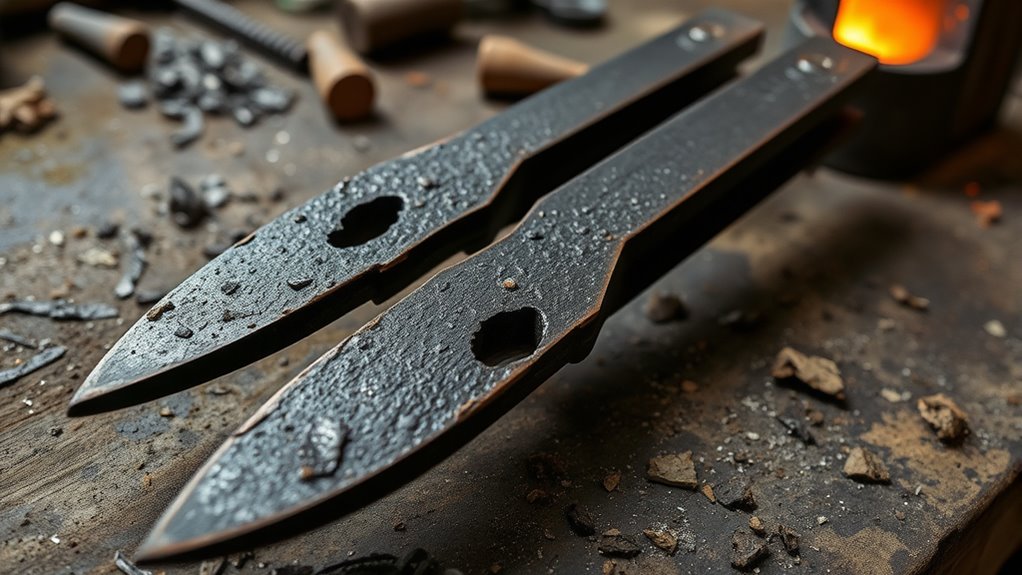
First, choose a steel that’s durable and easy to work with. Then, use precise cutting methods to shape your pieces accurately. Incorporating antioxidants during the shaping process may help reduce oxidation and improve the quality of your steel. Additionally, ensuring proper safety precautions while working with metal can prevent injuries and ensure a smoother fabrication process. Proper material selection is essential for achieving the desired strength and longevity of your log tongs. Finally, refine and smooth the edges to guarantee your components fit and function perfectly.
Selecting Suitable Steel
Choosing the right steel is essential for guaranteeing your homemade log tongs are strong and durable enough to handle heavy logs. Look for steel with a suitable composition that combines strength and flexibility, such as high-carbon or alloy steels. These types of steel offer the necessary toughness to grip logs securely without easily bending or breaking. Additionally, consider corrosion resistance, especially if you plan to store your tongs outdoors or in humid environments. Steel with added chromium or other corrosion-resistant elements will last longer and require less maintenance. Avoid soft or low-quality steels, as they won’t provide the strength needed for heavy-duty log handling. Selecting the appropriate steel from scrap sources ensures your tongs will perform reliably over time.
Precise Cutting Techniques
To guarantee your log tongs come together with precision and strength, focus on cutting and shaping the steel components accurately. Use precision measurement tools like a square, tape measure, and marker to mark your cuts precisely. ensure your measurements are double-checked before cutting to avoid mistakes. When operating power tools such as angle grinders or cut-off saws, prioritize power tool safety by wearing safety goggles, gloves, and hearing protection. Keep your hands steady and follow the marked lines carefully, making slow, controlled cuts for clean edges. Take your time to verify your work frequently, preventing errors that could weaken the tongs or cause safety issues. Precise cutting sets a solid foundation for the rest of your project, ensuring durability and effective performance.
Shaping and Refining
Shaping and refining your steel components is crucial to guarantee the log tongs are strong and functional. Start with steel forging to form the basic shapes of your tongs. This process involves heating the steel until it’s malleable and then hammering it into the desired form. Once the shape is set, you focus on precise cutting to remove excess material and refine edges. Proper shaping ensures the tongs will grip logs securely. After shaping, heat treatment is essential. It involves heating and quenching the steel to improve hardness and durability. This step enhances the strength of your tongs, preventing bending or breaking during use. Careful shaping combined with effective heat treatment results in log tongs that are both reliable and long-lasting.
Creating the Tongs’ Jaws and Handles

Creating the tongs’ jaws and handles is a essential step in ensuring your homemade log tongs are effective and comfortable to use. Start by attaching wooden handles to the steel jaws for a sturdy grip. Choose quality wood and sand down rough edges for comfort. You can also add decorative designs to the handles, giving your tongs a personalized touch. Secure the handles firmly using rivets or welding, ensuring they stay in place during use. The handles should be long enough to provide leverage without causing strain. For added style, carve patterns or paint the wooden handles, but prioritize safety and durability. This step balances functionality with aesthetics, making your log tongs both practical and visually appealing.
Assembling the Parts Securely

Ensuring the parts are assembled securely is essential for the safety and effectiveness of your log tongs. You should use proper welding techniques to join the steel components firmly, preventing any weak points. After welding, consider surface treatments like grinding or rust-proof coatings to enhance durability and prevent corrosion. For a stronger bond, double-check that the jaws and handles are aligned correctly before welding. Here’s a quick overview:
| Step | Action |
|---|---|
| 1 | Use appropriate welding techniques for strong joints |
| 2 | Clean welds with grinding tools for smooth surfaces |
| 3 | Apply surface treatments to prevent rust |
| 4 | Test the assembly for stability and strength |
Following these steps ensures your homemade log tongs are safe, durable, and ready for heavy use.
Adding Finishing Touches for Durability
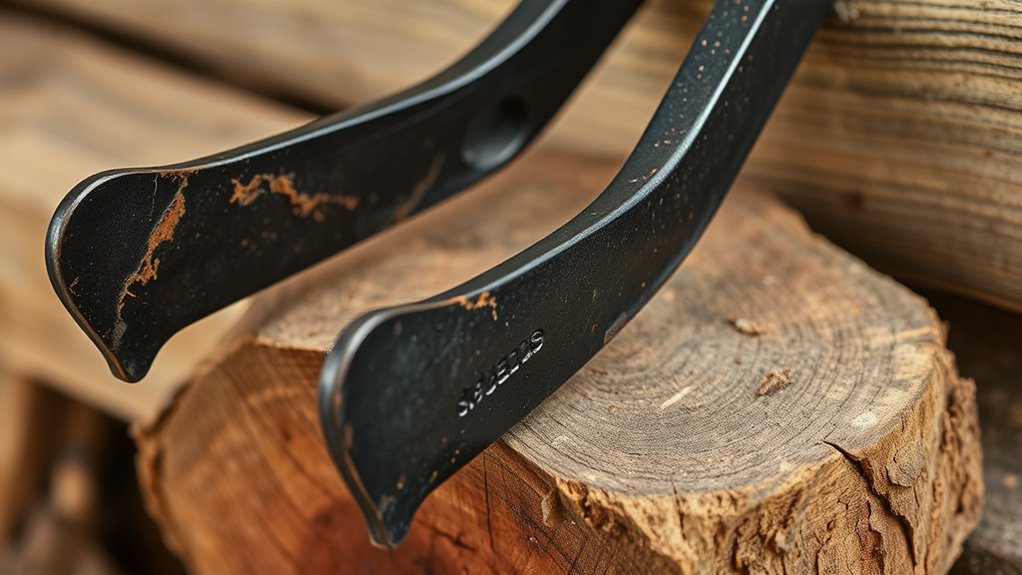
To maximize your log tongs’ durability, adding finishing touches like rust-proof coatings and protective paints is essential. These surface finishing steps help prevent rust prevention issues that can weaken the steel over time. Applying a high-quality metal paint or rust inhibitor creates a barrier against moisture and environmental elements, extending your tongs’ lifespan. Make sure to clean and sand the surface thoroughly before coating to ensure proper adhesion. Focus on areas prone to exposure, such as joints and gripping surfaces. Regular maintenance, including reapplying protective coatings when needed, keeps your homemade log tongs in top condition. These finishing touches not only enhance durability but also improve the overall appearance of your tools, making them safer and more reliable for heavy-duty use.
Testing and Adjusting Your Homemade Tongs

Before using your homemade log tongs for heavy-duty tasks, it’s important to test their functionality and make necessary adjustments. First, examine the joints and gripping surfaces for signs of metal fatigue, which could weaken the tongs over time. Test the tongs by gripping a few small logs to ensure they hold securely without slipping. Check for smooth operation, adjusting the tension if needed. Also, inspect the steel for corrosion resistance; if you notice rust or corrosion, consider applying a protective coating to prolong the tongs’ lifespan. Tighten any loose bolts or welds to prevent failure during use. Proper testing and adjustments ensure your tongs are safe, reliable, and ready to handle the demands of heavy logging tasks.
Tips for Safe and Effective Use

Using your homemade log tongs safely starts with maintaining a firm grip and staying aware of your surroundings. Always wear personal protective equipment like gloves and steel-toed boots to protect yourself from splinters or falling logs. Use proper lifting techniques—bend at your knees, keep your back straight, and lift with your legs to avoid injury. Confirm your tongs are secure on the log before lifting to prevent slipping. Keep a clear area around you to avoid tripping hazards. Communicate with others nearby to coordinate movements.
| Tip | Why it Matters |
|---|---|
| Wear PPE | Protects against splinters and heavy loads |
| Check Tongs Before Use | Ensures safety and grip reliability |
| Use Proper Techniques | Reduces injury risk during lifting |
Frequently Asked Questions
What Types of Scrap Steel Are Best for Making Log Tongs?
When choosing scrap steel for making log tongs, focus on recycling scrap with strong steel properties. Look for scrap steel that’s durable, resilient, and easy to weld, such as old car parts or structural steel. These types of scrap are ideal because they have the right strength and flexibility needed for effective log handling. Recycling scrap steel not only saves money but also guarantees you get quality material for your homemade tongs.
How Thick Should the Steel Be for Durable Tongs?
Did you know that steel with a hardness of 40-50 HRC is ideal for durability? For your log tongs, opt for steel that’s at least 1/4 inch thick, ensuring strength and longevity. You should consider heat treatment processes to improve steel hardness, making your tongs more resistant to wear and breakage. Thicker steel combined with proper heat treatment guarantees sturdy, reliable tools for handling logs safely and effectively.
Can I Customize the Tongs’ Grip Size?
You can definitely personalize the grip size of your log tongs for better grip comfort. Use handle materials like wood, rubber, or leather to improve comfort and control. Adjust the length and diameter of the handles to fit your hand size, making it easier to handle heavy logs safely. Customizing the grip ensures you have a secure hold, reducing fatigue and increasing safety during use.
What Safety Equipment Is Recommended During Fabrication?
Imagine sparks flying like fireworks as you craft your tools. During fabrication, you should wear protective gear—safety glasses, gloves, and a dust mask—to shield yourself from heat, debris, and fumes. Keep your tools well-maintained, checking for sharp edges and loose parts to prevent accidents. Proper safety equipment and ongoing tool maintenance guarantee you stay safe while transforming scrap steel into sturdy, custom log tongs.
How Do I Prevent Rust on Homemade Log Tongs?
To prevent rust on your homemade log tongs, start with rust prevention techniques like applying protective coatings such as paint, oil, or rust inhibitors. Regularly clean and dry the tongs after use to minimize moisture contact. You can also store them in a dry place. These steps help shield your tongs from rust, ensuring they stay functional and last longer in your woodworking or logging projects.
Conclusion
As you finish assembling your homemade log tongs, you realize how a simple scrap of steel turned into a reliable tool. It’s almost poetic how a chance find and your effort created something durable and useful. Every time you use them, you’ll remember that sometimes, the best projects come from unexpected sources. With your new tongs, you’re ready to tackle logs, knowing you built them yourself—proof that creativity and coincidence can forge something truly valuable.
